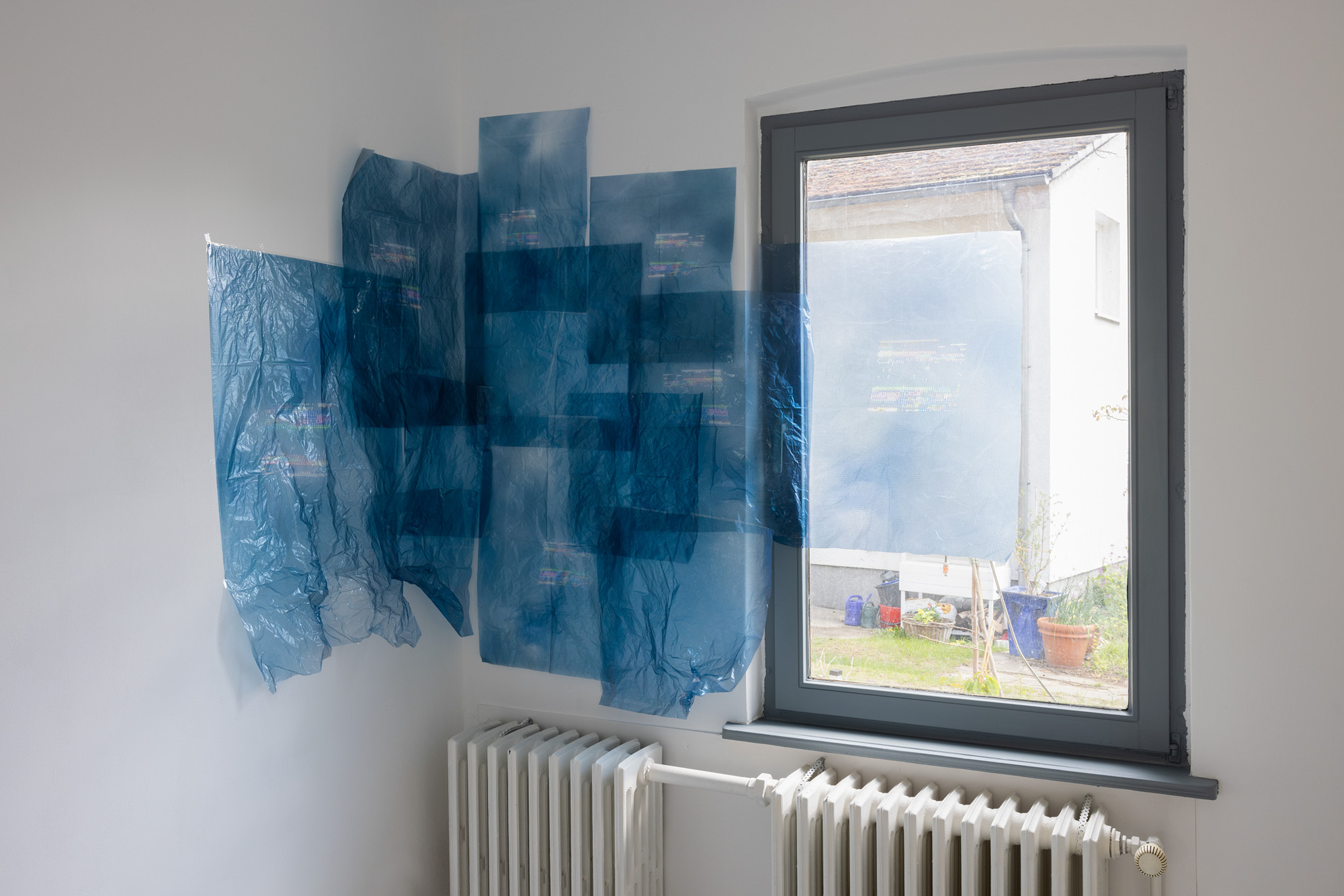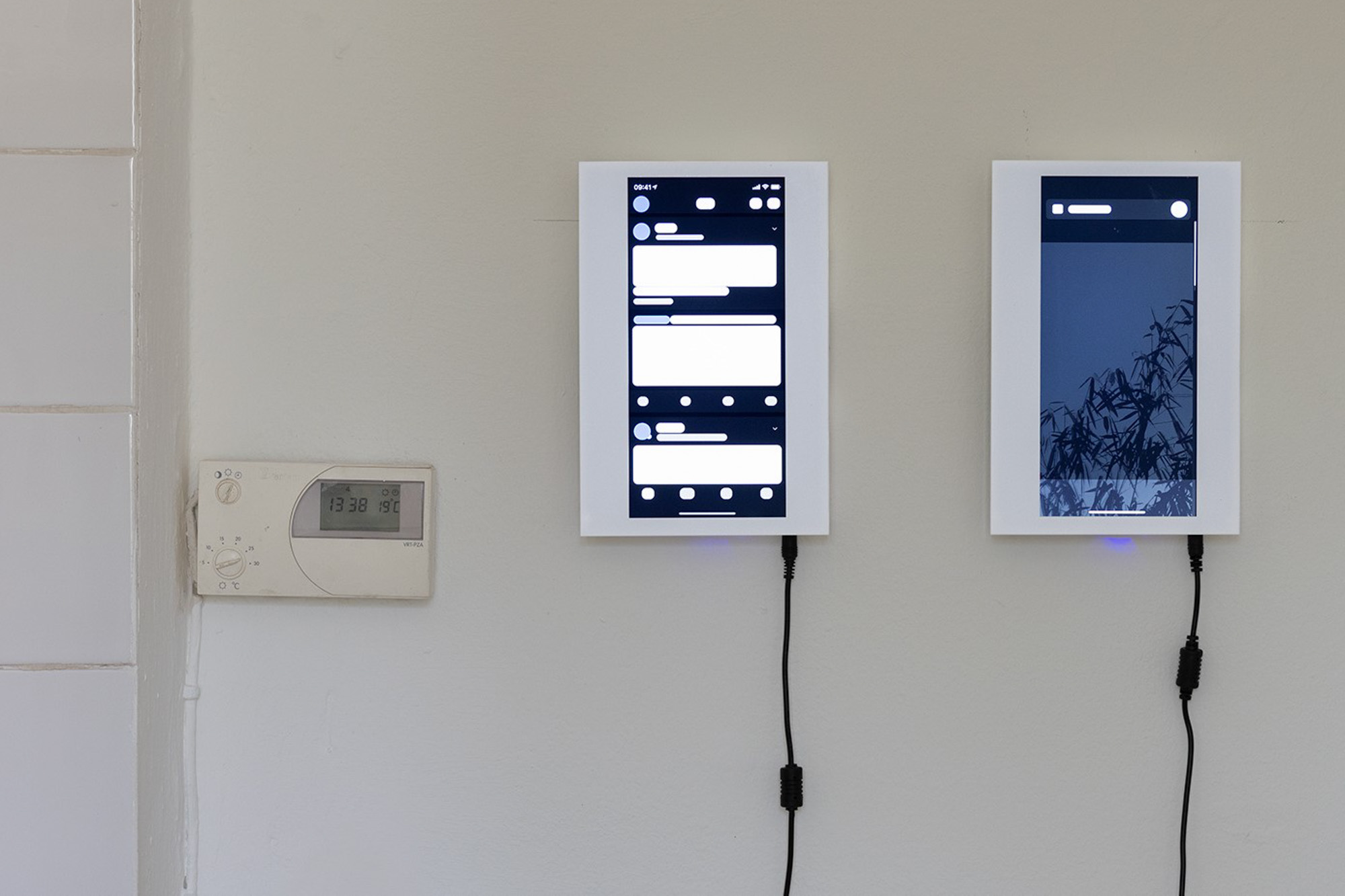Aaajiao’s “I was dead on the Internet”
By Frances Arnold

Installation view of AAAJIAO’s biubiu, 2022, digital prints and film, dimensions variable, at "I was dead on the Internet," Wannsee Contemporary, Berlin. Photos by Andrea Rossetti. All images courtesy the artist and Wannsee Contemporary.
In 2020, the Berlin-based artist aaajiao publicly criticized the Chinese government’s response to the devastating floods that swept through the country’s central and eastern provinces from June to September that year. His view was shared via his primary Weibo account, which had more than 9,000 followers. Like other social-media platforms, the microblogging site is subject to censorship, with users who fall foul of Weibo’s hazy rules risking anything from temporary account suspension to jail time. Aaajiao’s comment resulted in the deletion of the account: abruptly silenced, an online presence of more than a decade vanished.
This experience was the catalyst for his solo exhibition “I was dead on the Internet” at the Berlin gallery Wannsee Contemporary. From a starting point of one’s virtual persona being disappeared—including their networks, portfolio, and credentials—the show’s multimedia displays imagine how we might reclaim and reoccupy the internet not as users but as owners.

Installation view of AAAJIAO’s Siu~, 2021, prints on cellophane, dimensions variable, at "I was dead on the Internet," Wannsee Contemporary, Berlin.
Several works point to the vulnerability of a digital presence, and how a controlled internet, whether governmentally regulated or dominated by a handful of tech giants, makes online existences readily extinguishable. Take Siu~ (2021), for example, which consists of uncut sheets of flimsy cellophane candy wrap, creased as if they had been crumpled and then smoothed, and printed with a faint image of LED lights that look like a spectrum. Emblematic of the apparent disposability of online lives through its materials, the work also speaks to digital culture’s promotion of the enticing, the successful, the literal eye-candy.
Visible from outside the gallery was biubiu (2022), which comprises a series of seemingly unrelated photos—of cooking, food, a melting snowman, and a heron at dusk, for example—taken on an iPhone, printed onto transparent film, and attached to the space's front window. Susceptible to being washed out as the natural light changed over the course of the day, the images have an ephemeral quality that befits the fading significance of photos as they move further down social-media feeds. Aaajiao alludes not only to social-media censorship in certain geographies, but also to the relentlessness of status sharing.
That the natural world appears in several of these iPhone snapshots is no coincidence; throughout the exhibition, the artist used nature as a metaphor for how we might reconsider how we engage with the internet. For instance, Fabric, computational wind, OCD, search (2021) is a wall-mounted LCD screen similar in size and shape to a mobile phone, showing a monochrome video of swaying bamboo. Here, aaajiao compares the plant’s constant movement to the internet’s continuous updating and refreshing. Indeed, the bamboo is part of a networked system even greater than the internet: nature.

Installation view of AAAJIAO’s (from left to right) Consensus, geopolitics, chain, battery, 2021, LCD screen and video: 10 sec, and Fabric, computational wind, OCD, search, 2021, LCD screen and video: 12 sec, at "I was dead on the Internet," Wannsee Contemporary, Berlin.
The video work is one of four, each backdropped by the interface of social-media platforms Twitter, Instagram, Clubhouse, and Facebook, respectively. Redacted messages scroll upwards on the screens. All the while, the videos mimic a function available on iOS phones of switching between dark and day modes, synchronizing these mesmerizing screens to the rhythms of nature. In aaajiao’s work, these natural motifs point to a purer, more democratic online existence, their circularity implying endurance beyond even the most zealous of censors. In the context of discussions around the Web3 era of decentralized ownership and control—versus the monopoloid possession of today’s virtual caches—as well as Germany’s zealous approach to data privacy, aaajiao’s conceptual call for an internet revolution is timely.
The bucolic location of Wannsee Contemporary reinforced aaajiao’s ideas through a different kind of decentralization. Located far from downtown Berlin in the city’s most southwesterly corner, the ten-month-old spot’s lakeside locale feels far outside the capital’s network of central galleries—and as such, loaded with possibilities.

Installation view of AAAJIAO’s icon 008, 2019, screen print on chevron board with metal frame and acrylic paint, 79 × 99 cm, at "I was dead on the Internet," Wannsee Contemporary, Berlin.
“I was dead on the Internet” marked a continuation of aaajiao’s longstanding investigation into human identities in cyberspace. A kind of postmortem and grieving for the artist’s own virtual death, the exhibition could also be read as a warning against the unquestioning pouring of personal data into the ownership of Google, Amazon, Alibaba, and the like, until we are exhausted and have nothing left to give.
Aaajiao’s “I was dead on the Internet” was on view at Wannsee Contemporary, Berlin, from May 1 to July 16, 2022.







